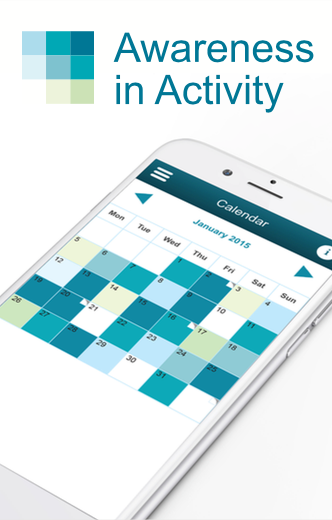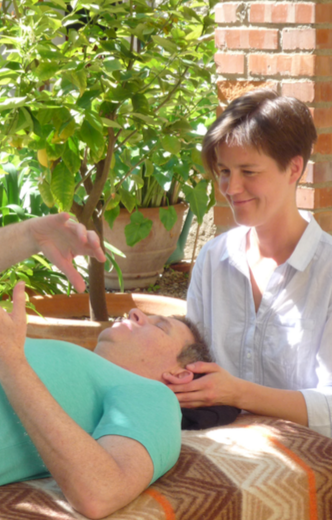To start this second year Alexander Technique teacher trainee article, I'd like to share the reason why am I so interested in this topic. When I started the Alexander Technique lessons,
I soon experienced a whole range of changes, physical as well as mental. I remember the wonderful feeling of going up, space and lightness as well as the easy, calm and relaxing atmosphere during the lessons. On the other hand the changes, some of them different to what I was maybe expecting, made me feel quite puzzled. I have always been active, doing a lot of sports and physical exercise, my body felt strong and I didn't have any complaints. Soon after I started the Technique, one body-part after another started aching and hurting. I thought the Alexander work was making me weak. But what it was doing, it was making me aware of and able to feel my body and how the way I was using the body was actually causing strain and pain on it. The physical part was easy to understand and it also eased rather quickly. What was more difficult to accept was why was I feeling emotional pain as well?
I couldn't understand if the uneasy feeling really was connected to the Alexander Technique lessons I was having, and if so, was there any rational reason to go on with them? Somehow I trusted that the changes and sensations were good even if not always comfortable and I did continue with my lessons. Years later, when starting the AT teacher training, the same process started again and was even more intense this time. I noticed that all of us on the training course were going through similar things, and it obviously wasn't always easy for any of us. Quite often, we hear the teachers telling us “It's part of your process.” What is the “process” and why is it so difficult sometimes, does it have to be so difficult? These were my guiding questions and a reason to start finding out what, why and how?
I will not be able to give all the answers in this second year article and my references are limited, as I'm only in the beginning of my research. The whole area of the study of emotions is rather new in the scientific world and new research is being done all the time and a lot about the emotions remains unexplained. I will map some of the psychophysical events I've found to be in connection with the emotions and give some ideas generally, why changing is not always easy, not forgetting that every one of us is unique, with one-of-a-kind experiences and nervous system, every process is unique, special and different.
A young girl asks a wise old woman, "How does one become a butterfly?"
With a twinkle in her eye, the old woman replies, "You must be willing to give up being a caterpillar."
I think F.M Alexander was well ahead of his time in the western world, inventing a principle which nowadays goes into the vast category of body-mind techniques. One of his main principles is that the Self is a whole, a unity of body and mind and that these two cannot be separated.
I must admit that when I began my investigation, I, in common with most people, conceived of “body” and “mind” as separate parts of the same organism, and consequently believed that human ills, difficulties and shortcomings could be classified as either “mental” or “physical” and dealt with on specifically “mental” or specifically “physical” lines. My practical experiences, however, led me to abandon this point of view and readers of my books will be aware that the technique described in them is based on the opposite conception, namely, that it is impossible to separate “mental” and “physical” processes in any form of human activity. (Alexander 1932, 1985:21)
The division between body and mind originates from René Descartes time two centuries ago. From thereon, the division between the psyche and soma has been separated, where medical science dealt with the physical body and the matters of soul were left to the church. This agreement with the Pope made it possible for Descartes to obtain bodies for dissection. Currently, a change is happening in the scientific world and the relationship between the mental and physical is more acknowledged as more detailed neuroscientific information is becoming available. Emotions have a very important bridge-like role in the psychophysical whole, connecting the mind and the body, as well as working as a link between the unconscious and conscious.
To explain the emotions, depends on the approach. The age-old division of emotions into “basic five passions of gladness, sadness, love, hatred and desire” (Descartes) no longer shares consensus, but invites critical examination (Kagan 2007:xi). The traditional scientific theory of emotions is the James Lange-theory from the 19thcentury, which argues that emotions are caused by changes in the bodily state i.e. A baby cries because of a change in the bodily state which the baby feels as pain or dis-ease and cries. Accordingto the latest research in the fields of psychoneuroimmunology and psychobiology, there is now evidence that the mind also affects the body and that the information is possibly carried both ways (Pert 1997:137, 2000, Hartley 2004:33-34).
There is a constant flow of information in the body and constant changes in the bodily state. The amount of information that flows is enormous, of which only a small fraction will reach our consciousness, we are conscious of only about 5% of our cognitive activity (Lipton 2005). The unconscious mind is a powerful processor processing information with a speed of 40 million bits/sec[1]where as the consciousness is operating with 40 bits/sec. There are different mechanisms as to how the information is traveling, and from the point of view of the emotions, think the chemical information flow is a very interesting one, as it provides understanding about the physiology behind the emotions.
There are three groups of ligands in what Dr. Candace Pert calls the “chemical nervous system”. The first group is the neurotransmitters like dopamine and serotonine generally made in the brain to carry information across synapses. The second category consists of steroids like testosterone and the stress hormone cortisol. The third and largest group are the neuropeptides for example endorphin, insulin and prolactin.
These chemicals she has named the ‘molecules of emotion’. We have receptors on the surface of each cell for these information carriers to attach to. Places where a high density of receptors are located, are along both sides of the spine, in various parts of the brain, heart and the digestive system (Pert 1998:141). The chemical information is transported not only to different parts of our brain and nervous system, but all over the body possibly through the central and autonomic nervous systems, the endocrine system and the immune system the blood, lymph, cerebrospinal and interstitial fluids (Pert 1997:27, 130, Rossi, 1986:182-3). This enables a chemical communication between the autonomic and central nervous system“ It is (these) peptides and their receptors that make the dialogue between conscious and unconscious processes possible” (Pert 1997:188)
Looking into the brain, the emotional centre is the limbic system. The limbic system is located above the brain stem under the cortex, in the middle of the so-called mammalian brain (LeDoux 2004:98). So physiologically, the emotional centre is located in-between the old and new parts of the brain. Roughly speaking, the older parts of the brain are in control of the life maintaining activity and survival, whereas our consciousness and intellect are located on the higher parts of the cortex and within the newest part of the brain, the prefrontal cortex.
The large human brain can be seen as a mechanism that allows us to process the huge amount of information we need to be able to perceive the world, respond to it, move through and act on it. All this sensory information from in and outside the body is flowing through our sensory mechanisms and being filtered through our emotional brain. Only a fraction of the total information will reach our consciousness after being filtered through our emotions, beliefs and perceptions.
How much can we trust our senses? Alexander is talking about the “untrustworthy sensory appreciation”. [2]The reality is different to what we interpret it to be. On the other hand, real is as real as we believe it to be. A fear or sensation is real to us. The information that reaches our consciousness has gone through many filters by the time it becomes a sensation or a thought. The sensory mechanisms are so influenced by personal perceptions that we largely experience what we want to experience, or remember from the past (Wilkinson 2003:27) The habitual way of using ourselves has accommodated our sensory mechanism to such an extent that it is difficult for us to tell what is “real”. Alexander's famous sentence: “Don't trust your feelings” applies here too, what appears real to us might be very far away from the reality.
From the point of view of fear, when a signal of threat gets to the brain, a whole lot of subconscious physiological events happen, triggered by the amygdale, being the ‘alarm centre’ of the brain that prepares the body to fight, flight orfreeze (Hartley, 2004:32, LeDoux, 1998:202). I find it fascinating that these fear reactions are for neurological reasons, difficult to control or be over-ruled by our conscious thoughts. “Conscious control is not always anoption.” [3]To give a practical example from the Alexander world, at a moment of a fear of falling, it might be impossible to “let your knees go” no matter how clear the conscious wish is! There is naturally a whole variety of other reasons too for not letting the knees go other than a possible fear reaction.
Starting Alexander Technique lessons is a process whereby I think we need to evaluate and possibly change some of our perceptions and beliefs about ourselves and therefore also our psycho physical use. To make a change in a life-long habit, a perception formed in early childhood, to alter a nervous system and reflexes that have been reinforced in a certain way on a daily basis, to make a change in any one of these, inevitably affects all of them. Luckily this doesn't come too easily! It is a healthy mechanism of the body to maintain its balance in the changing environment without changing too much and to not allowing us to “lose ourselves”. Our system has its habits and therefore, a healthy resistance against change.
I have often come across a belief that the Alexander Technique doesn't deal with emotions. Since no activity can be separated from the emotions, except for some rare cases of injury or illness, not dealing with emotions, can create a dilemma. Every AT teacher and training course surely has come across the question of how to deal with emotions and has possibly had to find a way of dealing with them to their best (personal) abilities. During F.M's time, early 20thcentury, emotions were dealt with differently than nowadays, and were generally left for individuals to deal with in private. The knowledge that we have about, and the importance of emotions, is different nowadays. Emotions play a major role in decision-making and learning and they can even be seen as the bridge between the mind and the body. It is known that suppressing, denying or ignoring emotions is not dealing with them and therefore not good for personal well-being. Clearly we have to find ways of working with the emotions in the psychophysical learning process of the Alexander Technique.
In a learning context, pleasure and play are important factors. What makes the human brain so unique is the large prefrontal cortex, this is the place for activities of higher consciousness like learning. In the human prefrontal cortex is the largest density of endorphin receptors, even higher than in the limbic system which is the emotional centre! Endorphin is the body's own morphine giving us the feeling of bliss and pleasure. Without a doubt, pleasure, play, positive thinking and learning goes hand-in-hand! I could well imagine that the endorphin receptors along the spine and connected to the breathing centre are also involved with the wonderful, sometimes blissful feelings experienced during an Alexander lesson.
On the other hand we know that sometimes the Alexander work can bring up emotions we associate easily as negative emotions, like sadness, hurt, anger even rage. These and other “negative” emotions are the ones that we so easily leave unexpressed, don't feel or don't want to feel for various personal and cultural reasons. In the long term, a healthier approach would be to acknowledge that “every honest emotion is a positive emotion” (Pert 1997:193).Sometimes the real emotions are different than what they first appear to be, for example what comes out as anger, might actually be an upper layer of hurt or fear. There is a place and need for a good variety of emotions in keeping in touch with oneself, as well as for example, maintaining healthy boundaries.
Emotions and traumatic experiences that have not been dealt with, remain stored in the body and can be stimulated for example by focused attention, touch, breathing, postural changes and movement. Touch itself is a powerful tool and very closely related to emotions and early experiences. I have a feeling that there are many levels of “letting go” in Alexander terms, from letting go of undue muscular tension in the body to dis-charge of traumatic experience and held energy. The dis-charge may come out as memories, movement, trembling, temperature changes, nausea, crying, laughter, change in breathing to name some. I hope that we, as Alexander Technique teachers, would have some basic knowledge about these possible events when dealing with such a sensitive area as the body-mind connection.
“What happens in the process?” is one of my initial questions. At the moment, I see it is as a process of becoming whole, like the word health originates from the word whole. It is like defragmenting the system, making the flow possible and allowing the physical and mental to have the space to be in motion.
I am a person for whom it is helpful to know the reasons why, andin my process, it has been extremely helpful to understand some of the mechanisms behind the events that are happening. For example when feeling resistance in my system and thoughts coming up supporting that resistance, I can now calm myself down and be aware that I might be entering something new, something I in the first place experience as unfamiliar and threatening.
I have some great teachers, friends and colleagues who have taught me a lot and who have patiently spent hours answering my questions, thank you. If you look at the Bibliography you will see that almost all the books I've used to research and write this article are written close to the new millennium, before or after. The new neuroscientific information is radically changing the field of emotions. The psychological views have changed a lot, new theories, knowledge and literature are coming out all the time. This brings a new challenge for the 21 century AT teacher too.
We don't need to become psychotherapists, but I feel there is a need to be aware of the mechanism of the mind, the healing process and the power of touch. Inevitably the whole will start to heal when given a chance and emotional healing is part of it. To make a change, alters the person's habits, even life-style. How people react to these changes varies. Personally, I felt that radical renewals in my life were necessary. Maybe they were not all that necessary, but on first reaction, an attempt to maintain homeostasis by controlling the outer world. It would be helpful for an AT teacher to recognize and inform the person as to what is happening in the process and during the lessons. Even suggest other help if it is needed. In any case it is not right to start a process and then leave people alone and confused as the changes are starting to happen.
Inhibition, direction and conscious control, these are the key ideas that separate Alexander Technique from many other body-mind techniques. And this is why I think the Alexander Technique has great potential, because it is a thinking technique.[4]We are combining the body-work to the mind- work through increase of awareness, inhibition, direction and conscious control. The aspect of learning, personal development and the possibility of making a change is there. As F.M says, “Change is the Ultimate Reality”.[5]
To finish this article for now, I will try to give an answer to a question given to me from my training course teachers; “How am I practicing the Technique in my process concerning emotions”?
I'm tempted to say I am not using the Technique directly as such to work with the emotions. Personally, I feel that the “work is working”. To draw a line as to when and how am I working with an emotion or psychological issue is nearly impossible. People react differently and the issues vary as well. Some people may get clear images during the AT work, insight or memories of an event, for example an accident, injury or a childhood recollection. It is also possible that there are issues, preverbal, prenatal or for some other reason memories without a clear cognitive picture or story attached to them but an emotion, even an overwhelming one, may emerge. When a breakthrough from the unconscious to consciousness happens, people may choose different ways of reacting. Here the line between inhibition and suppressing is a valuable and really tricky one, as it asks for a lot of understanding of the psychophysical whole and it's functioning.
For my own process, I can't give a clear example of what is happening, exactly when, and how. The system has a tendency towards balance and healing in itself, and when given a chance, this process is happening, largely unconsciously. It seems that practicing the Alexander Technique has been enough of a chance for my system to start the balancing and healing process. That when I'm stepping out of the way, the “right thing happens by itself”[6]. The things familiar and habitual to me have actually created blockages on many levels and when I give myself time, space and freedom, a lot of release and psychophysical “cleaning up” can happen naturally, inevitably and at it's own speed.
I think this might be a reason why Alexander Technique teachers have been able to safely and successfully use a technique with therapeutic effects without receiving much training in the field of psychology. Because the work is not, when used correctly, a manipulation or direct working on psychological issues. The process may happen naturally in its own time, at a tempo, in which the student/client’s system is able to process things. The teacher is “doing nothing” but directing and giving direction by using his or her hands. This is, of course, an activity itself and has a great influence. The changes should, however, happen as a response in the system, not manipulated or forced by the teacher.
This article strives to look behind the curtain and see what the mechanisms are, how and why is the “Work working”. It is also an attempt to raise our awareness about the emotions being in the middle of the psyche and soma, affected by everything happening in the body and mind and definitely by the AT work as well. I am hoping that in the future, any person starting the Alexander Technique and entering a “process” wouldn't have to feel so left alone with their changes as I was when I started “doing nothing”; thinking my neck free, and sending my head forward and up. I do feel and strongly believe that the process is worthwhile and is not only just a struggle, but a wonderful journey.
How much more there is now to living! Instead of our drab slogging forth and back to the fishing boats, there’s reason to life! We can lift ourselves out of ignorance, we can find ourselves as creatures of excellence and intelligence and skill. We can be free! We can learn to fly!
-Richard Bach: Jonathan Livingston Seagull
I'd like to give a special thanks to my friends, colleagues and teachers, especially:
Gitte Dollerup Fjordbo, Elke Mastwijk and Francien Schoonens for your help and support in my research and in the process of writing this article. Karen Volpert for helping me especially with the language.
Thank you!!
Maria Vahervuo, September 2009
BIBLIOGRAPHY
Alexander, F.M: Man's Supreme Inheritance, Conscious Guidance and Control in Relation to Human Evolution in Civilization, 1910
Constructive Conscious Control of the Individual, 1924
Use of the Self, 1932
Ballard, K On Learning and Teaching the F.M. Alexander Technique, Conscious Control Volume 2 Number 2, 2008
Carrington, W.H.M Thinking Aloud, Talks on Teaching the Alexander Technique, 1994
The Foundations of Human Well-Being, The Work of Professor Magnus and the F. Matthias Alexander Technique, 1994
Chance, J Anatomy of Addiction, Direction Volume 1 Number 9
Dollerup Fjordbo, G On the Development of Habit, 1992
Garlick, D The Garlick Report (Emotions), Direction Volume 1 Number 9
Hartley, L Somatic Psychology, Body, Mind and Meaning, 2004
Johnson-Chase, M Do we cry because we grieve, or do we grieve because we cry?, Direction Volume 1 Number 9
Kagan, J What is Emotion, 2009
LeDoux, J Emotional Brain, 1998, 2004
Levine, P.A with Waking the Tiger, Healing Trauma, 1997
Frederick, A
Lipton, B The Biology of Belief, Unleashing the Power of Consciousness, Matter and Miracles, 2005
Morris, W.C: Hazards & Hope, The role of Alexander Technique in recovery from childhood sexual abuse. Direction Volume 1 Number 9
Nataraja, S: The Blissful Brain, Neuroscience and proof of the power of the meditation, 2008
Pert, C.B: Molecules of Emotions, Why You Feel the Way You Feel, 1997
Your Body Is Your Subconscious Mind, 2000
Rossi, E.L: Psychobiology of Mind-Body Healing, 1986
Rubenfeld, I Emotions: The Unacknowledged Partner in Mind/Body Integration, Direction Volume 1 Number 9
Wilkinson, S.R Coping and Complaining, Attachment and the language of dis-ease, 2003
[1] bits/sec. Nerve impulses per second. (in Lipton 2005, Norretranders T (1998) The User Ilusion:Cutting Consciousness Down to Size)
[2] “I came to realize that my reaction to a particular stimulus was constantly opposite of that which I desired, and that in my search for the cause of this, I discovered that my sensory appreciation (feeling) of the use of my mechanism was so untrustworthy that it led me to react by means of a use of myself which felt right, but was, in fact, too often wrong for my purpose.” (Alexander, 1932, 1985:49)
[3] “- When our functioning is controlled by the oldest parts of our brain - the reptilian and limbic parts, which are the parts that are concerned with mere survival, the newer and more sophisticated parts of the brain - the neocortex and esp. the pre-frontal cortex cannot function properly if at all. – This rules out the possibility of a `conscious choice´ in a given situation and thus in those cases the letting go of a compensatory tension in an Alexander-way may be at best a very difficult task.” (Dollerup Fjordbo, www.more-dimensions.dk)
[4] “You think that the Alexander Technique is physical; I tell you that it is the ,most mental thing that has been discovered.” F.M Alexander (Carrington 1994:19)
[5] Carrington, W. 1994 Thinking Aloud, Authors Preface
[6] “Stop doing the wrong thing and the right thing will happen” F.M. AlexanderAt first the whole sentence used to put me off. I have spend a lot of energy becoming more non judgmental, getting away from thinking in terms of ‘right and wrong’ and here it is; the man I admire for his technique using the words I'd like to banish from my vocabulary all together.







